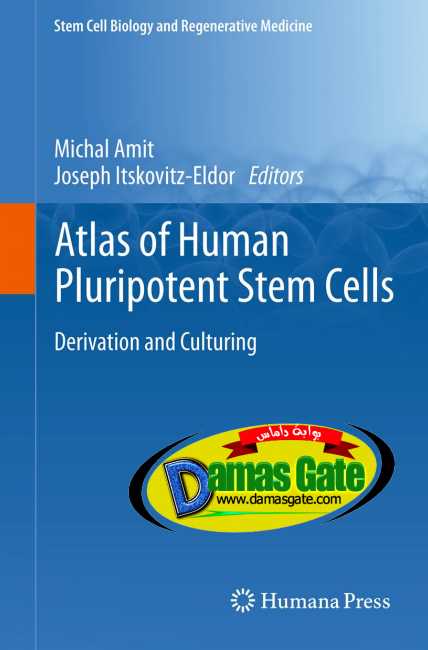Atlas of Human Pluripotent Stem Cells: Derivation and Culturing

Introduction
Traditionally, human ESCs (hESCs) are co-cultured with inactivated mouse embryonic
fi broblasts (MEFs) as supporting layers, and the medium is supplemented
with a high percentage of fetal bovine or calf serum (FBS) (Thomson
et al. 1998 ) .The feeder layer serves a dual role of supporting hESC expansion
and preventing spontaneous differentiation. However, such conditions are not
appropriate for clinical and industrial purposes due to variations between batches
of FBS and MEFs, and to the risk of exposure of the cells to animal pathogens.
Modifications that prevent xeno-contamination in the culture system include the use
of a defi ned medium supplemented with serum replacement, without animal
products. The MEFs should be replaced by human feeder cells or matrix.
Accumulating data demonstrate that induced pluripotent stem cells (iPSCs) can be cultured in similar
conditions as those for hESCs (Takahashi and Yamanaka 2006 ; Takahashi et al. 2007 ) ;
therefore, improvements in hESC culture conditions will also apply to those of iPSCs.
Human pluripotent stem cells, including human embryonic stem cells and induced pluripotent stem cells, are a key focus of current biomedical research. The emergence of state of the art culturing techniques is promoting the realization of the full potential of pluripotent stem cells in basic and translational research and in cell-based therapies. This comprehensive and authoritative atlas summarizes more than a decade of experience accumulated by a leading research team in this field. Hands-on step-by-step guidance for the derivation and culturing of human pluripotent stem cells in defined conditions (animal product-free, serum-free, feeder-free) and in non-adhesion suspension culture are provided, as well as methods for examining pluripotency (embryoid body and teratoma formation) and karyotype stability. The Atlas of Human Pluripotent Stem Cells - Derivation and Culturing will serve as a reference and guide to established researchers and those wishing to enter the promising field of pluripotent stem cells.
2012 -- 156 Pages -- ISBN: 161779547X -- PDF -- 11 MB
Download
http://s18.alxa.net/s18/srvs2/02/003...luripotent.rar

Introduction
Traditionally, human ESCs (hESCs) are co-cultured with inactivated mouse embryonic
fi broblasts (MEFs) as supporting layers, and the medium is supplemented
with a high percentage of fetal bovine or calf serum (FBS) (Thomson
et al. 1998 ) .The feeder layer serves a dual role of supporting hESC expansion
and preventing spontaneous differentiation. However, such conditions are not
appropriate for clinical and industrial purposes due to variations between batches
of FBS and MEFs, and to the risk of exposure of the cells to animal pathogens.
Modifications that prevent xeno-contamination in the culture system include the use
of a defi ned medium supplemented with serum replacement, without animal
products. The MEFs should be replaced by human feeder cells or matrix.
Accumulating data demonstrate that induced pluripotent stem cells (iPSCs) can be cultured in similar
conditions as those for hESCs (Takahashi and Yamanaka 2006 ; Takahashi et al. 2007 ) ;
therefore, improvements in hESC culture conditions will also apply to those of iPSCs.
Human pluripotent stem cells, including human embryonic stem cells and induced pluripotent stem cells, are a key focus of current biomedical research. The emergence of state of the art culturing techniques is promoting the realization of the full potential of pluripotent stem cells in basic and translational research and in cell-based therapies. This comprehensive and authoritative atlas summarizes more than a decade of experience accumulated by a leading research team in this field. Hands-on step-by-step guidance for the derivation and culturing of human pluripotent stem cells in defined conditions (animal product-free, serum-free, feeder-free) and in non-adhesion suspension culture are provided, as well as methods for examining pluripotency (embryoid body and teratoma formation) and karyotype stability. The Atlas of Human Pluripotent Stem Cells - Derivation and Culturing will serve as a reference and guide to established researchers and those wishing to enter the promising field of pluripotent stem cells.
2012 -- 156 Pages -- ISBN: 161779547X -- PDF -- 11 MB
Download
http://s18.alxa.net/s18/srvs2/02/003...luripotent.rar